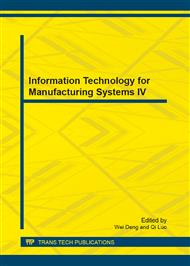[1]
Mohammad Sima, Tuğrul Özel. Modified material constitutive models for serrated chip formation simulations and experimental validation in machining of titanium alloy Ti–6Al–4V[J]. International Journal of Machine Tools and Manufacture, 2010, 50(11): 943-960.
DOI: 10.1016/j.ijmachtools.2010.08.004
Google Scholar
[2]
Z P Wan, Y E Zhu, H W Liu, et al. Microstructure evolution of adiabatic shear bands and mechanisms of saw-tooth chip formation in machining Ti-6Al-4V[J]. Materials Science and Engineering: A, 2012, 531 (1): 155–163.
DOI: 10.1016/j.msea.2011.10.050
Google Scholar
[3]
R Ding, Z X Guo. Microstructural evolution of a Ti–6Al–4V alloy during β-phase processing: experimental and simulative investigations[J]. Materials Science and Engineering: A, 2004, 365 (1-2): 172–179.
DOI: 10.1016/j.msea.2003.09.024
Google Scholar
[4]
C Z Duan, L C Zhang. Adiabatic shear banding in AISI 1045 steel during high speed machining: Mechanisms of microstructural evolution[J]. Materials Science and Engineering: A, 2012, 532 (1): 111–119.
DOI: 10.1016/j.msea.2011.10.071
Google Scholar
[5]
S H Rhim, S I Oh. Prediction of serrated chip formation in metal cutting process with new flow stress model for AISI 1045 steel[J]. Journal of Materials Processing Technology, 2006, 171 (3): 417–422.
DOI: 10.1016/j.jmatprotec.2005.08.002
Google Scholar
[6]
J Lorentzon, N Järvstråt, B L Josefson. Modelling chip formation of alloy 718[J]. Journal of Materials Processing Technology, 2009, 209(1): 4645–4653.
DOI: 10.1016/j.jmatprotec.2008.11.029
Google Scholar
[7]
MSC. Software, MSC. Marc Volume A: Theory and User Information, Version: (2011).
Google Scholar
[8]
G R Johnson, W H Cook, A constitutive model for metals subjected to large strains, high strain rates and high temperatures, in: Proceedings of the Seventh International Symposium on Ballistics, Hague, Netherlands, 1983, 54: 1–7.
Google Scholar
[9]
U Andrade, M Meyers, K Vecchio, et al. Dynamic recrystallization in high-strain, high-strain-rate plastic deformation of copper[J]. Acta Metall mater, 1994, 42 (9): 3183–3195.
DOI: 10.1016/0956-7151(94)90417-0
Google Scholar
[10]
Calamaz M, Coupard D, Girot F. A new material model for 2D numerical simulation of serrated chip formation when machining titanium alloy Ti–6Al–4V[J]. International Journal of Machine Tools and Manufacture, 2008, 48(3): 275-288.
DOI: 10.1016/j.ijmachtools.2007.10.014
Google Scholar
[11]
Yada H. Prediction of Microstructural Changes and Mechanical Properties in Hot Strip Rolling[J]. Accelerated Cooling of Rolled Steel, 1987: 105-119.
Google Scholar
[12]
Senuma T, Suehiro M, Yada H. Mathematical Models for Predicting Microstructural Evolution and Mechanical Properties of Hot Strips[J]. ISIJ international, 1992, 32(3): 423-432.
DOI: 10.2355/isijinternational.32.423
Google Scholar
[13]
Jun Liu, Yuli Liu, He Yang, et al. Microstructure simulation of TC4 blade precision forging process based on multiple field coupling analysis[J]. Journal of Plasticity Engineering, 2007, 4(14): 64-68.
Google Scholar


